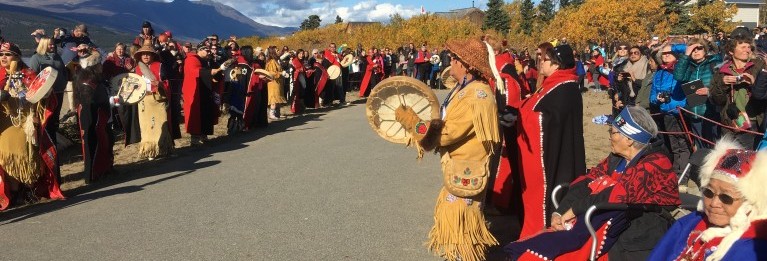
Haa kusteeyí
Language

"We who are Tagish and we who are Tlingit, our heritage has grown roots into the earth since the olden times. Therefore we are part of the earth and the water."
We know our Creator entrusted us with the responsibility of looking after the land into perpetuity, and the water, and whatever is on our land, and what is beneath our land. So those coming after us, we will give them that responsibility into perpetuity. Our elders have assigned us the task of showing respect to things. Therefore, we will look after our land as they have told us to do, as did our elders, because we were the first to come to this land that is now called Canada."
"We will be the bosses of our land. We will watch over our land as we have agreed upon, and as we ourselves manage things according to our traditions. We will bequeath it to those coming after us into perpetuity. We will work with people to strengthen our heritage, to give a firm foundation to our peoples lives, and to manage our land well. We will work with all peoples to take good care of our land, and all the resources of this land, as we have agreed on. We will be our own masters. We who are the Tagish, and we who are the Tlingit, will protect our land, so that the things will be according to what has been agreed on, so that they will live by it."
"According to what we have agreed on, we will reform the way we work with the government. We will work together with mutual respect, and act truthfully [toward each other]. We will all work together, those who own the land, and those who use the land. We will manage together, the land and the water and what is on the land. Then everything will be prepared for those coming after us."
"As we have agreed on, so we will act. We will work as our elders instruct us, and improve the lot of those coming after us. We will use our land with other nations. Moreover, we will look after our land well, so that our descendants can see how good it is, and in this way too, we will respect our land from which we were born."
Tagish Language Version by Ms. Lucy Wren
(Assisted by Ms. Clara Schinkel, Ms. Margaret Workman, and Mr. John Ritter)
Yukon Native Language Center
December 2002
Tagish
This language was spoken in the southern lakes area of the Yukon, mainly at Marsh Lake, Carcross and Tagish Lake. Linguistically, Tagish is closely related to Kaska and Tahltan. There are just a few individuals remaining who retain some knowledge of the language.
Before the arrival of non-natives in the southwestern Yukon, the Tagish language faced pressure from the culturally dominant Tlingit language and was in the process of replacement. The Tagish people intermarried with the Tlingit and adopted their customs and language. Descendants of the Tagish identify culturally with the Tlingit. They have matrilineal descent, belong to either Wolf or Crow clans, and conduct potlatches. The few remaining passive speakers of Tagish are fluent in Tlingit.
The name Tagish itself is a place name which means 'it (spring ice) is breaking up'.
Some well known Tagish personalities were Dawson Charlie and Skookum Jim. They helped discover the gold which resulted in the Klondike gold rush. Patsy Henderson was Skookum Jim's sororal nephew and was in the Klondike area when gold was discovered, but did not assist in the actual discovery of gold. He was well known for giving lectures to tourists. Johnny Johns was a relative (cousin) of Skookum Jim's and a well known guide. Angela Sidney was another relative of Skookum Jim's. She was a well known storyteller and one of the last fluent speakers of Tagish. Mrs. Sidney contributed probably more than anyone else to efforts to save the Tagish language from oblivion.
Tlingit
In the Yukon, the Tlingit language is spoken primarily in the communities of Carcross and Teslin. Tlingit is spoken as well by the native people living in the Atlin, B.C. area, and by large numbers of Alaskan natives who live in coastal settlements stretching along the Alaskan panhandle from Yakutat to Ketchikan. In spite of the geographic range of the language there is relatively little dialect diversity and all speakers can understand each other.
Fluent Yukon Tlingit speakers are generally aged 65 and older, although many Tlingit who are in the 50-65 age range do understand a certain amount of the language. No Yukon children are learning Tlingit as a first language.
Tlingit is distantly related to Eyak, an extinct language from the Alaskan coast, and to the Athapaskan family. Tlingit began spreading into the interior perhaps two to three centuries ago. The coastal Tlingit people controlled trade between Europeans and Athapaskans. Trade relationships were reinforced by marriage and the coastal language and culture spread into the interior. The clan system is strongest in those areas closest to the Tlingit. Many southwestern Yukon Athapaskan people are related to Tlingit people. Some Southern Tutchone Elders also speak Tlingit.
Carcross/Tagish First Nation Citizens, update your contact information
If you are a Carcross/Tagish First Nation Citizen and need to update or add your contact information to our database, fill out this form.